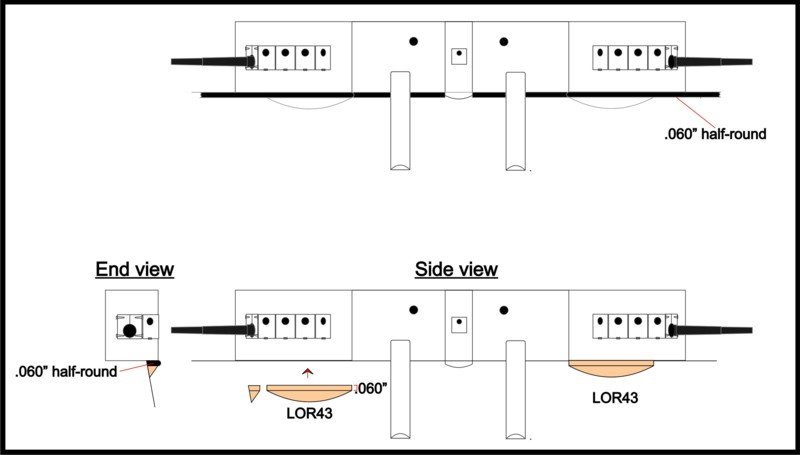-
Posts
408 -
Joined
-
Last visited
Content Type
Profiles
Forums
Gallery
Events
Everything posted by alross2
-
OK, WYOMING is going to Nic for rigging, so I'm back full-time on OREGON. Today was mostly printing out plans and parts lists and getting my head back into OREGON. Painted up a bunch of castings and started applying the photo-etched 6" casemate doors. There are five doors on each casemate, which is curved, so it takes a while to get them lined up.
-
The spring stay bails require a little patience and care to build. They are laser-cut .020" laser board but are surprisingly strong and flexible. They are best built off the mast. Two eyes are glued together, a light coat of thin CA is applied to them, then they are bent over a dowl (front bail) and 1/4" square stick (aft bail). The mast is drilled with a .022" bit, the bail is slid down over the mast, and a pin goes through the holes. Once everything is aligned, CA is applied to the end of the pin and the end is snipped off.
-
Never mind. I just read an earlier thread on the subject. Should have done so before asking...
-
What is the actual vertical distance between ratlines on a 19th C sailing vessel? I'm thinking maybe about 9".
-
The bobstay irons are going to be a bit fiddly to install. The arms are trimmed to length and a .020" hole drilled at the end of each, then through the stem. A pin is inserted through the three holes, glued to the arms and snipped off. By allowing them to pivot, it makes setting the angle easier when the bobstays are attached. Once they are in place, the irons can be glued in place.
-
There are 120 holes in the cap rail for belaying pins. I decided not to laser them in because of the potential for breakage. So, you have to drill them but there is a template in the kit that will make this less challenging. You align the first two holes with the space between the stanchions, drill the first hole, stick a belaying pin or piece of rod in the hole to maintain alignment, hold the template in place, and drill away. It actually only takes a few minutes and everything is consistent.
-
Stack brackets are installed. These are made from 1/64" x 1/16" britannia strips bent over a jig (included with the kit) and trimmed. As an aside, forceps are great for holding items for painting. These are cheap ones that I toss in lacquer thinner after I'm done painting. They clean up easily and can last for years.
-
Rather than spend hours looking, I thought I'd start here first. The plans I'm using to develop the kit of WYOMING were drawn by an actual schooner captain who is also a well-known researcher, so I have a warm fuzzy about their accuracy. There is no belaying plan, but that is not much of a problem. I can figure that out based on rigging plans for other schooners. The main problem is that there is no indication of where the halyards on the forecastle mast (that's what P & S called it, as well as #1) tie off. The plans do not show a fife rail nor a spider band on this forward-most mast. Like many schooners, this mast passes through the fore house and the boom jaw rest is quite close to the roof. WYOMING was flush-decked and did not have bulwarks, only a rail with stanchions which doesn't sound strong enough to support pin rails. There are no indications of pin rails anywhere forward. There are two large wooden bitts just forward of the house, each having two belaying pins, but this doesn't seem like enough to be the belaying points for this mast. So, does anyone have an illustraton of this particular configuration that would clear things up for me?
About us
Modelshipworld - Advancing Ship Modeling through Research
SSL Secured
Your security is important for us so this Website is SSL-Secured
NRG Mailing Address
Nautical Research Guild
237 South Lincoln Street
Westmont IL, 60559-1917
Model Ship World ® and the MSW logo are Registered Trademarks, and belong to the Nautical Research Guild (United States Patent and Trademark Office: No. 6,929,264 & No. 6,929,274, registered Dec. 20, 2022)
Helpful Links
About the NRG
If you enjoy building ship models that are historically accurate as well as beautiful, then The Nautical Research Guild (NRG) is just right for you.
The Guild is a non-profit educational organization whose mission is to “Advance Ship Modeling Through Research”. We provide support to our members in their efforts to raise the quality of their model ships.
The Nautical Research Guild has published our world-renowned quarterly magazine, The Nautical Research Journal, since 1955. The pages of the Journal are full of articles by accomplished ship modelers who show you how they create those exquisite details on their models, and by maritime historians who show you the correct details to build. The Journal is available in both print and digital editions. Go to the NRG web site (www.thenrg.org) to download a complimentary digital copy of the Journal. The NRG also publishes plan sets, books and compilations of back issues of the Journal and the former Ships in Scale and Model Ship Builder magazines.






